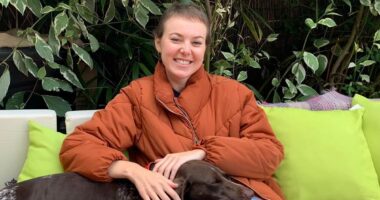Share this @internewscast.com
For those using weight-loss medications like Ozempic or Wegovy, navigating the Thanksgiving feast can be a challenging task, given the calorie-laden temptations.
Since their FDA approval in 2021, these GLP-1 drugs have revolutionized the field of weight management, originally intended for diabetes treatment and later celebrated for their remarkable efficacy in aiding weight loss.
These weekly injections, containing semaglutide (found in Ozempic and Wegovy) or tirzepatide (present in Mounjaro and Zepbound), act by imitating gut hormones to manage hunger signals, essentially informing the brain when the stomach is satisfied.
Though transformative, enabling individuals to lose up to 20% of their body weight, these medications often suppress the appetite so effectively that even a small amount of food can result in discomfort.
During a holiday synonymous with indulgence in hearty dishes, users of GLP-1s might either overindulge to the point of unease or restrict their intake excessively, leading to feelings of deprivation.
Traditional Thanksgiving favorites, such as buttery mashed potatoes and rich gravies, can further contribute to sensations of nausea and bloating.
But experts say anyone on a GLP-1 can still enjoy their favorite meals mindfully without skipping them by choosing smaller portions on a small plate, going easy on alcohol by limiting to one drink and staying hydrated with water, which curbs cravings, aids digestion and boosts energy while on your medication.

Thanksgiving’s rich, heavy foods can be challenging for GLP-1 users, risking discomfort from overeating or feelings of being deprived (stock image)
Portion control
Portion control on a GLP-1 is vital to enjoying the day.
These medications work by targeting both the brain and the stomach. They signal the brain to promote satiety while slowing digestion.
This dual action means a person feels full after just a few bites. Overeating can lead to a sense of being uncomfortably full and even nauseous.
Dr Alexander Dydyk, director of weight loss and wellness at HealthyU Clinics, said to aim for a balanced layout with turkey taking up half the plate and the remaining half split between vegetables, such as green beans or carrots, and carb-based sides, such as mashed potatoes or stuffing.
For some people, preventing that uncomfortable fullness requires some visual trickery.
Dydyk told the Daily Mail that people should use a smaller six-inch plate rather than a full-size dinner plate, ‘because you cannot overfill it.’
Erin Jowett, a registered dietitian, suggests adopting a ‘tasting tour’ approach. Instead of large servings, take small, sampler-sized portions of two to four bites for items like stuffing or casseroles.
She told the Daily Mail: ‘Because GLP-1 medications slow gastric emptying, the goal on Thanksgiving isn’t to skip joy, it’s to build a plate your stomach can actually handle.’
When it comes to pie, a simple visual cue can help: a slice roughly the size of a peace sign made with your fingers provides a satisfying taste of the dessert without overburdening the digestive system.
‘Food is always about priorities and trade-offs, and the holidays are no exception,’ Dydyk said.
‘Your goal is not perfection. It is making decisions that align with your long-term health.’

Erin Jowett, a functional registered dietitian, told the Daily Mail: ‘The goal on Thanksgiving isn’t to skip joy, it’s to build a plate your stomach can actually handle’

Val Warner, a dietitian and personal trainer advises eating protein and plants first, then adding small portions of indulgent foods to support blood sugar and energy
Eating order matters
The order in which a person on a GLP-1 eats their Thanksgiving meal matters, according to experts.
Jowett said: ‘I tell my clients to eat their protein first and fill half their plate with vegetables. This not only supports smoother digestion, but it also helps to prevent the micronutrient gaps I often see in people on weight loss medications.’
A GLP-1 user who fills up on mashed potatoes and rolls first might be too full to eat more nutritious turkey and vegetables, potentially missing out on key nutrients and feeling less satisfied overall.
Filling up on nutrient-dense foods first, on the other hand, helps stabilize blood sugar, which naturally reduces cravings for sugary desserts.
Valerie Warner, a dietitian and certified personal trainer, told the Daily Mail: ‘Sprinkle in your indulgences, such as mashed potatoes and desserts after having your protein and plants. Keep these servings at one-third of the plate.
‘Having these foods after you have protein and plants can be very supportive for maintaining lean body mass, managing blood sugars and overall energy.’

The above graph shows how prescriptions for weight-loss drugs including Wegovy and Zepbound have skyrocketed in the US since they were FDA-approved in 2021
Take an after-dinner walk
Incorporating movement after the meal is an effective way to support digestion, such as a family walk, Warner said.
A leisurely holiday stroll aids digestion by helping to move food through the stomach and intestines more efficiently, which can reduce bloating and discomfort.
It also helps moderate blood sugar levels. Research has shown that when people take a walk in the 60 to 90 minute window after a meal, changes in blood sugar are not only less extreme but also more gradual.
Warner said: ‘This may be light walking with the family for 10-15 minutes.
‘If you feel too full for dessert immediately after dinner, a brief stroll can create the space to return and enjoy a slice of pie without discomfort.’














